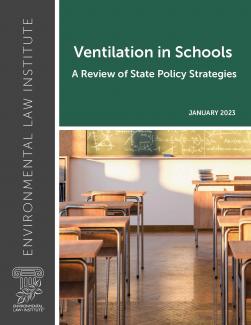
Building ventilation is a core strategy for improving indoor air quality. Well before the COVID-19 pandemic, research demonstrated the importance of outdoor air ventilation – and the related practice of air filtration – for reducing indoor exposure to infectious aerosols and to pollutants commonly found in indoor air. There are well-established methods that school facility mangers can employ to provide adequate ventilation and filtration.
The pandemic highlighted both the need for proper ventilation and filtration and the fact that millions of students attend schools with inadequate ventilation and indoor air quality. The burden of these conditions is not distributed equally, due in part to persistent disparities in school facility funding. Stronger state policies are needed to help make school buildings healthier now and better equipped to handle emergencies in the future.
This report suggests key policy strategies for states to consider in addressing school ventilation for general operations and during infectious disease emergencies. The report provides an overview of current state laws and regulations, highlighting examples that establish school ventilation requirements and that provide financial and technical assistance.
Overview of the Report
Most states have authority to address school ventilation and filtration through their public health, education, or occupational safety and health authorities. And many states already have one or more policies that address school ventilation in some manner. Yet most existing state policies lack the foundational elements of an effective and comprehensive approach: (1) clear ventilation and filtration requirements, (2) compliance oversight mechanisms, and (3) equitable financial and technical assistance programs.
Ventilation and Filtration Standards and Practices for General Operations. Ventilation and filtration requirements can be established as prescriptive standards (e.g., ventilation rate or filtration efficiency) or as required practices (e.g., HVAC maintenance and reporting). The requirements should build on well-established technical best practices, set clear expectations for school districts, and be framed in a way that allows schools to document compliance.
Planning for Future Infectious Disease Emergencies. States can build on initiatives implemented during the COVID-19 emergency to require schools to develop, regularly update, and implement a written airborne infectious disease plan that incorporates both ongoing ventilation/filtration measures and enhanced measures to be activated at times of higher risk.
State Oversight of School Ventilation. Many state laws and regulations require a state or local agency to conduct school facility inspections, but these inspections vary in scope and frequency. Where agencies do not conduct inspections at least annually, policymakers could require the school district to conduct a comparable inspection in intervening years and report the findings. Additional oversight tools include school facility recordkeeping and reporting, designation of a school IAQ point of contact, and implementation of a facilities complaint process at the school district level.
Financial and Technical Assistance. Many schools lack adequate funding for maintenance, operations, and capital improvements, and such schools are more likely to be located in historically underserved communities. Policymakers can help ensure equitable funding for ventilation by tapping existing federal and state funding programs and by creating new state programs that support school facilities generally or that focus on ventilation. A companion paper, State Funding for School Ventilation: A Review of State Policies, 2020-2022, describes in more detail several state financial assistance policies highlighted in the report.
Explore other materials from ELI’s Indoor Environments Program.
© Environmental Law Institute®